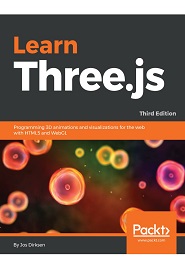
English | 2018 | ISBN: 978-1788833288 | 528 Pages | EPUB | 412 MB
Create and animate stunning 3D browser based graphics with Three.js JavaScript library
WebGL makes it possible to create 3D graphics in the browser without having to use plugins such as Flash and Java. Programming WebGL, however, is difficult and complex. With Three.js, it is possible to create stunning 3D graphics in an intuitive manner using JavaScript, without having to learn WebGL. With this book, you’ll learn how to create and animate beautiful looking 3D scenes directly in your browser-utilizing the full potential of WebGL and modern browsers. It starts with the basic concepts and building blocks used in Three.js. From there on, it will expand on these subjects using extensive examples and code samples. You will learn to create, or load, from externally created models, realistic looking 3D objects using materials and textures. You’ll find out how to easily control the camera using the Three.js built-in in camera controls, which will enable you to fly or walk around the 3D scene you created. You will then use the HTML5 video and canvas elements as a material for your 3D objects and to animate your models. Finally, you will learn to use morph and skeleton-based animation, and even how to add physics, such as gravity and collision detection, to your scene. After reading this book, you’ll know everything that is required to create 3D animated graphics using Three.js.
What you will learn
- Work with the different types of materials in Three.js and see how they interact with your 3D objects and the rest of the environment
- Implement the different camera controls provided by Three.js to effortlessly navigate around your 3D scene
- Work with vertices directly to create snow, rain, and galaxy-like effects
- Import and animate models from external formats, such as OBJ, STL, and COLLADA
- Create and run animations using morph targets and bones animations
- Explore advanced textures on materials to create realistic looking 3D objects by using bump maps, normal maps, specular maps, and light maps
- Interact directly with WebGL by creating custom vertex and fragment shaders
Resolve the captcha to access the links!